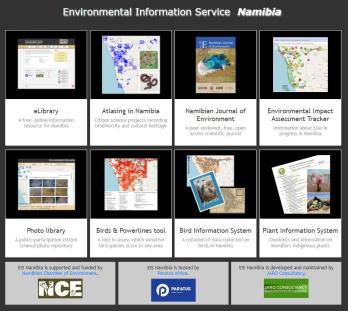Environmental Information Service of Namibia

The Environmental Information Service of Namibia (The EIS) is a searchable e-library with downloadable publications, reports, data sets, maps, legislation, theses, presentations and more.
+264 (0)61 240 140admin@n-c-e.org
The main purpose of the NCE is to support its Members to achieve the Aspirational Objectives, to fill gaps, and to promote sound environmental management in Namibia. The NCE does not compete with its Members, neither in the area of project implementation nor in the area of fund raising. In this context, the NCE wishes to respond to the collective requirements of its Members, both in how best it could provide support to the Membership, and also how the NCE and its collective Membership should prioritise work to enhance conservation and sustainable development in Namibia.
The Objectives are implemented through eight strategic programme areas.
Build and manage Namibia's Environmental Information Service comprising an e-library with references and downloadable publications, reports and data sets – the largest environmental library in Namibia; citizen science data collection via atlas projects (e.g. mammals, carnivores, snakes, invasive alien plants); a scientific on-line journal: Namibian Journal of Environment and the EIA Tracker, an online tool to promote transparency, public input and understanding of the EIA process in Namibia.
The NCE provides the home for Namibia's Environmental Information Service (EIS). This comprises a searchable e-library with downloadable publications, reports, data sets, maps, legislation, theses, presentations, etc; a citizen science atlasing platform with mammal, carnivore, snake, frog and invasive alien plant atlas projects ongoing, new atlases about to be added and an Atlasing app for mobile data collection; a landscape photographic component to help assess landscape changes over time; a scientific on-line e-journal, Namibian Journal of Environment and, most recently, the EIA Tracker, an online tool to promote transparency, public input and understanding of the EIA process in Namibia.